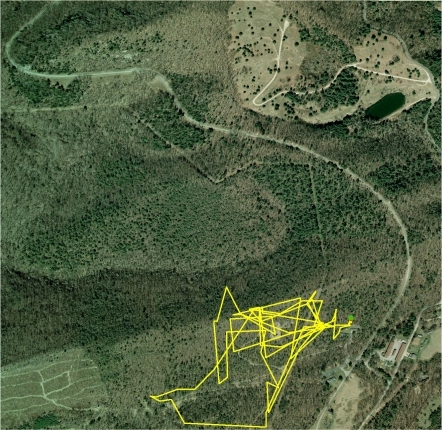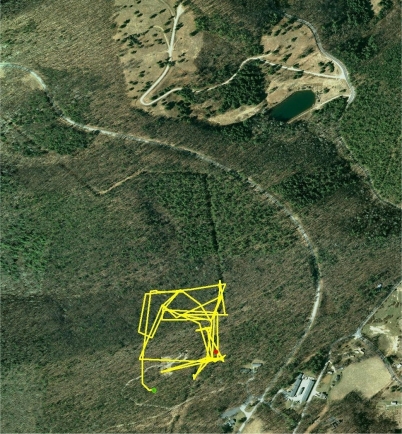M27 Male, 525 grams. This turtle, totally painted white, was found by an employee in 2012 in a parking lot within my study area, and was moved into the woods to avoid being run over. Likely an abandoned pet, he evidently remained in the area through 2 winter hibernations, and was found 6/8/14 meeting with turtle M19(M), only about 1000 feet from the parking area where he was originally found.
With most of the paint nearly warn off, he is being tracked as a member of this population. This turtle seems too large to have been aquired as a juvenile, and I wonder if he was taken from the wild as an adult nearby, and later released near where he was captured. His continued presence brings up a number of questions about box turtle homing abilities, as well as repatriation of adults to a new area (if indeed he was introduced here into a new home site).
M28 Photographed and moved off the road early morning 6/27/14 by Rebecca, a park employee. The turtle was photographed, but not measured or tagged, but at 3 years old, surely represents the youngest turtle found within this study area. Box turtles of this age are very rarely seen crossing roads, probably because they don't yet travel very far from their nest sites. Turtles M20 and M21 traveled into this area during the 2013 season.
M31, a 330 gram male, was found on 7/30/14 in a power line ROW while tracking M3. Certainly a long ranging transient. What direction he came from is unknown.
2014 was the warmest year on records.
The past winter was particularly cold with numerous periods of record lows, 7 snow storms, and otherwise dry, but didn't appear to have any effects on turtle emergence dates. The numerous species of native orchids emerged somewhat early, hardy, and with a profusion of new small individuals. There have been more Bald faced hornet nests seen this summer than for many previous years, making tracking hazardous.
M13 (M) Was tracked from emergence, but disappeared suddenly with 2 transmitters on-board. The quick disappearence hinted that he had been collected while crossing the highway, but M13 was re-found much later in the season, across the highway in the woods (orange route) on 9/21/14, over 3 months after disappearing out of radio range. He was tracked into hibernation at the exact same stump hole used last season.
M31(M) undoutedly a transient, traveled 2.3 GPS miles after being found 7/30/14 in the power line ROW on top of the ridge. He quickly crossed the deep drainage and climbed to the top of the next ridge and traveled nearly straight-line WSW. He was not observed mating or meeting, but was found late in the mid-summer season so it is not known how long he was in this local population or how many residents he met.
After traveling well outside of my normal access area, he is now carrying a contact information capsule in case he is found in the future.
UPDATE: M31 was moved back to the exact original find location on Aug 29th where he headed west on a new long straight course. His new designations are M31A (red), M31B (green), M31C (blue), M31D (aqua), and M31E. Tracking M31 has taken a lot of time and effort away from tracking resident turtles this season.
M31E hibernated in the power line ROW close to the original find site.
New turtles found this season (all males)
Slightly over 1500 GPS turtle locations were recorded this season. Seven new turtles click here were found and added to the turtle catalog. One or two of these are almost certainly transients, so are not really part of this local population, but all except a juvenile were tagged and tracked through the end of the season or until being lost. Six of the new turtles are males, and one is unknown gender.
Two of the new turtles were found by employees on the road, one was found by me while tracking, and the remainer were found either mating or meeting with previously tagged turtles .
Although most previously tagged turtles' behavior was expected, there were also a few surprizes this season. Turtles M14 (M) and M4 (F), (likely the oldest and youngest residents), traveled far outside any previous year's activity area, and both also found water sources and spent significant amounts of time soaking before moving on, eventually hibernating far from their previous winter sites.
Eastern Box Turtle
Terrapene carolina carolina
A Relict Population Doomed To Extinction?
Green Dot = Emergence, Red Dot = Hibernation, Blue Dot = NEW FIND, White Dot = Dead































